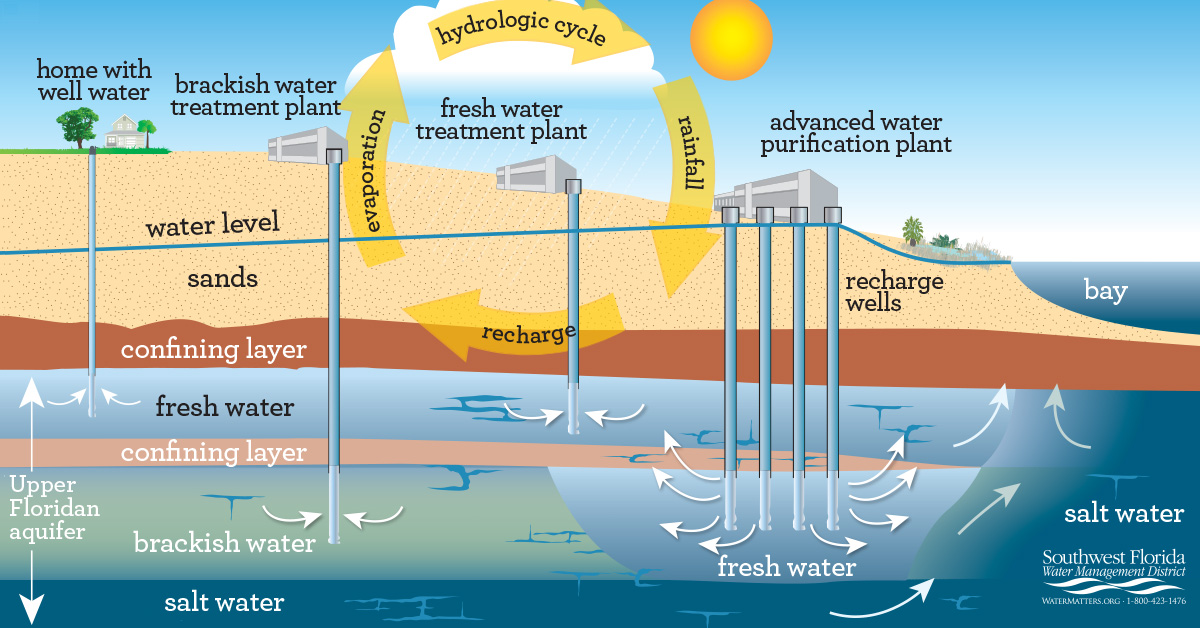Published May 6, 2024
Once again, we are pleased to present our annual water quality report covering all testing performed between Jan. 1 and Dec. 31, 2023.
Each year, the city of Clearwater’s Public Utilities department presents residents with important information about the city’s drinking water quality in an annual consumer confidence report. For 2023, the city of Clearwater met and exceeded all state and federal drinking water standards.
As part of the U.S. Environmental Protection Agency’s “Safe Drinking Water Act Amendments,” all water systems throughout the country must publish this annual report.
Printed copies are available upon request, and the report is also available in Spanish. If you’d like one mailed to you, call Clearwater Public Utilities at (727) 562-4960.
Our water is monitored for many kinds of substances on a very strict sampling schedule. The water we deliver must meet specific health standards. Here, we only show those substances that were detected in our water (a complete list of all our analytical results is available upon request). Remember that detecting a substance does not mean the water is unsafe to drink. Our goal is to keep all substances detected below their respective maximum allowed levels.
The state recommends monitoring for certain substances less than once per year because the concentrations of these substances do not change frequently. In these cases, the most recent sample data are included, along with the year in which the sample was taken.

You are invited to participate in regularly scheduled meetings. The city of Clearwater Council normally meets at 6 p.m. on the first and third Thursday of each month at Clearwater Main Library. The meeting agendas are published on the city's website at myclearwater.com. For more information, call (727) 562-4090.
The Pinellas County Board of County Commissioners meets typically twice a month (usually, but not always) on the first and third Tuesday. The first meeting in the month begins at 9:30 a.m. The second monthly meeting is in two parts. Agenda items are discussed with the board at 2 p.m., after which there is a break and the board reconvenes at 6 p.m. The public is invited to attend these meetings, held in the fifth-floor Assembly Room of the Pinellas County Courthouse, located at 315 Court St. in Clearwater. For more information, call (727) 464-3485.
Tampa Bay Water's Board of Directors meetings are held on the third Monday of every month at 9:30 a.m. at Tampa Bay Water at 2575 Enterprise Road, in Clearwater. For more information, visit their website at tampabaywater.org or call (727) 796-2355.

While your drinking water meets U.S. EPA's standard for arsenic, it does contain low levels of arsenic. U.S. EPA's standard balances the current understanding of arsenic's possible health effects against the costs of removing arsenic from drinking water. U.S. EPA continues to research the health effects of low levels of arsenic, which is a mineral known to cause cancer in humans at high concentrations and is linked to other health effects such as skin damage and circulatory problems.
Some people may be more vulnerable to contaminants in drinking water than the general population. Immunocompromised persons such as persons with cancer undergoing chemotherapy, persons who have undergone organ transplants, people with HIV/AIDS or other immune system disorders, some elderly, and infants may be particularly at risk from infections. These people should seek advice about drinking water from their health care providers. The U.S. EPA/CDC (Centers for Disease Control and Prevention) guidelines on appropriate means to lessen the risk of infection by Cryptosporidium and other microbial contaminants are available from the Safe Drinking Water Hotline at (800) 426-4791 or water.epa.gov/drink/hotline.
The sources of drinking water (both tap water and bottled water) include rivers, lakes, streams, ponds, reservoirs, springs, and wells. As water travels over the surface of the land or through the ground, it dissolves naturally occurring minerals and, in some cases, radioactive material and can pick up substances resulting from the presence of animals or from human activity.

Contaminants that may be present in source water include:
- Microbial Contaminants, such as viruses and bacteria, which may come from sewage treatment plants, septic systems, agricultural livestock operations, and wildlife.
- Inorganic Contaminants, such as salts and metals, which can be naturally occurring or result from urban stormwater runoff, industrial or domestic wastewater discharges, oil and gas production, mining, or farming.
- Pesticides and Herbicides, which may come from a variety of sources such as agriculture, urban stormwater runoff, and residential uses.
- Organic Chemical Contaminants, including synthetic and volatile organic chemicals, which are by-products of industrial processes and petroleum production and can also come from gas stations, urban stormwater runoff, and septic systems.
- Radioactive Contaminants, which can be naturally occurring or the result of oil and gas production and mining activities.
In order to ensure that tap water is safe to drink, the U.S. EPA prescribes regulations that limit the amount of certain contaminants in water provided by public water systems. The Food and Drug Administration (FDA) regulations establish limits for contaminants in bottled water, which must provide the same protection for public health.
Drinking water, including bottled water, may reasonably be expected to contain at least small amounts of some contaminants. The presence of contaminants does not necessarily indicate that the water poses a health risk. More information about contaminants and potential health effects can be obtained by calling the U.S. EPA’s Safe Drinking Water Hotline at (800) 426-4791.
City of Clearwater residents use approximately 11 million gallons of potable water every day. Approximately 60 percent is pumped from groundwater wells owned and operated by the city; the remaining daily demand is supplied by water purchased from Pinellas County Utilities. The groundwater source for Clearwater is the Floridan Aquifer. This aquifer is one of the major sources of groundwater in the United States and underlies all of Florida, southern Georgia, and small parts of adjacent Alabama and South Carolina.
Pinellas County Utilities receives drinking water from Tampa Bay Water, a regional water supplier, which in turn becomes part of the water supplied to the residents of Clearwater. The water supplied by Tampa Bay Water -- a blend of groundwater, treated surface water, and desalinated seawater -- becomes part of the supply for the residents of Clearwater. Eleven regional wellfields pumping from the Floridan Aquifer are the primary source for the regional groundwater supply. The Alafia River, the Hillsborough River, C.W. Bill Young Regional Reservoir, and the Tampa Bypass Canal are the primary supplies for the regional treated surface water supply. Hillsborough Bay is the primary supply of seawater for the regional desalinated supply. For more information on the Tampa Bay Water system, visit tampabaywater.org.


In 2023, the Florida Department of Environmental Protection (FDEP) performed source water assessment on our system. The assessment was conducted to provide information about any potential sources of contamination in the vicinity of our wells. There are 44 potential contaminant sources, ranging from low to moderate levels of concern. FDEP also performed source water assessments for the Tampa Bay Water facilities in 2023. All assessment results are available on the FDEP Source Water Assessment and Protection Program website at dep.state.fl.us/swapp, or from Tampa Bay Water, 2575 Enterprise Road, Clearwater, FL 33763, or by calling (727) 796-2355.

If present, elevated levels of lead can cause serious health problems, especially for pregnant women and young children. Lead in drinking water is primarily from materials and components associated with service lines and home plumbing. We are responsible for providing high-quality drinking water, but we cannot control the variety of materials used in plumbing components. When your water has been sitting for several hours, you can minimize the potential for lead exposure by flushing your tap for 30 seconds to two minutes before using water for drinking or cooking. If you are concerned about lead in your water, you may wish to have your water tested. Information on lead in drinking water, testing methods, and steps you can take to minimize exposure is available from the Safe Drinking Water Hotline at (800) 426-4791 or at epa.gov/safewater/lead.